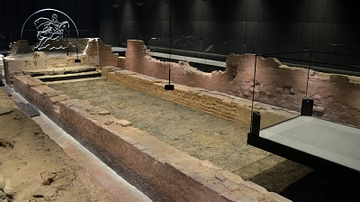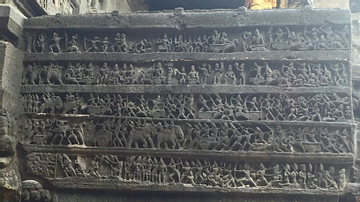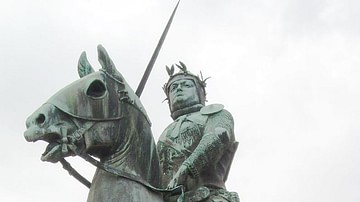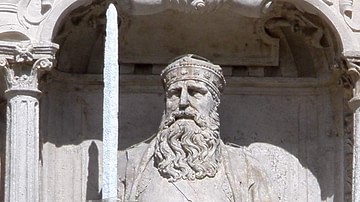Search Images
Browse Content (p. 1086)

Image
London Mithraeum
The remains of the London Mithraeum, dramatically presented inside the modern Bloomberg Building in the city of London. The Temple, dedicated to the god Mithras, the Lord of Light, was built in the 3rd century CE by an unknown Roman citizen...

Image
Sir William Wallace
Etching depicting Sir William Wallace (c. 1270-1305 CE) who was a Scottish knight and national hero who fought for his country’s independence from England. (From Smollett's "History of England", 1757 CE)

Image
The Armies of the Rashtrakutas (Eighth to Tenth Centuries CE)
This war scene shown in a temple frieze in the Kailashanatha Temple built by the Rashtrakuta emperor Krishna I (756-773 CE) depicts the Mahabharata war. The soldiers' arms and armour however, belong to the period of the imperial Rashtrakutas...

Image
Sir Henry Hotspur Percy
The death of Sir Henry 'Hotspur' Percy (1364-1403 CE) at the Battle of Shrewsbury who was the most famous member of the noble Percy family of northern England (A Chronicle of England: B.C. 55 – A.D. 1485, J.W.Edmund)

Image
Tomb of Edward the Black Prince
The tomb of Edward of Woodstock (1330-1376 CE), the eldest son of English king Edward III of England, Prince of Wales from 1343 CE and the scourge of the French nobility. Known as Edward ‘the Black Prince’ (from the 16th century CE). (Canterbury...

Image
Robert Du Guesclin
A statue of Robert du Guesclin (c.1320-1380 CE), a French knight and national hero also known as the ‘Eagle of Brittany’. (Sculptor: Emmanuel Fremiet. Dinan, France)

Image
Sir James Douglas
Sir James Douglas, aka 'Black Douglas' (c. 1286-1330 CE), a Scottish knight who fought for his country's independence from England. He is here shown with fellow fighters Robert Bruce and William Wallace. (Entrance hall frieze by William Hole...

Image
Sir William Wallace
A statue of Sir William Wallace (c. 1270-1305 CE), a Scottish knight and national hero who fought for his country’s independence from England. (Edinburgh Castle)

Image
Rodrigo Diaz de Vivar - El Cid
A statue of Rodrigo Diaz de Vivar - 'El Cid' (1043-1099 CE) the famed Spanish knight and general. Arco de Santa Maria, Burgos Spain.

Image
Robert Guiscard
Robert Guiscard (c. 1015-1085 CE) was a Norman knight who fought with success against the Byzantine and Arab Empires. Painting by Merry-Joseph Blondel (1781–1853 CE). (Palace of Versailles, France)